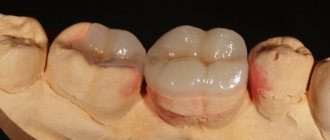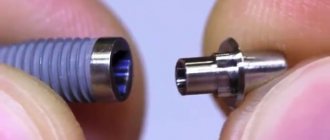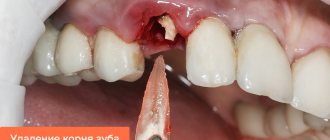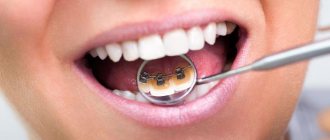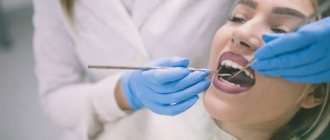Dental tissue is one of the most durable types of tissue in the human body. In theory, teeth should last a lifetime, but this is not always the case. Many people already have teeth that need treatment from a young age. One of the innovative ways to correct damaged teeth is a stump inlay. This method of prosthetics allows you to save even “worn-out” teeth and make them outwardly indistinguishable from natural ones.
Design Features
A stump inlay is a structure made from a patient’s dental impression for attaching a crown. This type of denture is a combination of cast material of different alloys. The prosthesis is installed into the dental canal from the inside to strengthen the damaged dental crown.
A stump tab is the only way to restore a maximally damaged tooth (more than 70%).
The upper part of such a prosthesis looks like the stump of a ground tooth, which is where the name “stump” comes from. For special strength, the prosthesis is made by casting from various metal alloys.
This prosthetic model is not a crown. This is a completely different structure. It is difficult to do without this extremely reliable type of prosthetics in modern dentistry.
Stump tab, pin and crown: which is better
It is impossible to compare core inlays and crowns. These are prostheses of fundamentally different purposes, properties and configurations. And only the dentist can decide which type of prosthetics is preferable for a particular patient.
However, a core inlay is not used for teeth with very thin walls. In this case, a crown can more effectively cope with the task of strengthening the crown of the tooth. The crown will be especially strong if it is attached to the stump tab. At the same time, it is possible to maximally strengthen even the most worn teeth and completely restore their natural chewing function.
Both the post and core support strengthen damaged teeth. However, this type of prosthesis guarantees super-strength dental fasteners, uniform chewing load and protection from further destruction.
A very important advantage of the inlay is its fastening using a cement composition. This guarantees a tight fit to the tooth of any degree of wear and prevents the formation of cracks.
General overview
Dental inlays are orthopedic micro-prosthetic structures that replace cavities in the crowns of damaged teeth. As a result of the restoration, the organs acquire an anatomical shape and relief that is as close as possible to nature.
In fact, this is another type of filling, but the only difference is that the production is carried out outside the patient’s mouth , and in the laboratory using a plaster cast.
This process allows you to get rid of shrinkage of the composite material , which inevitably occurs during classical filling.
Also, using the tab, it is possible to recreate an exact copy of the missing fragment of a destroyed tooth. All the tubercles on the surface of the product perfectly follow the contours of natural elements.
Microprostheses are characterized by a fairly strong macro and microstructure, which is resistant to abrasion. The products are installed already formed, while the filling material has a plastic consistency.
Inlays are a more progressive method of restoring the integrity of teeth. They provide longer and more stable operation compared to standard treatment.
Types of tabs
Typically, the dentist recommends a particular type of inlay to the patient. Let's look at the main features of such structures.
Stump prosthetic models are used in the form of two types of dentures:
- collapsible;
- cast.
Cast stump inlay
Cast ones are used most often; they are also called pin ones. They are manufactured at high temperature and pressure. Such models include a main platform (for holding the tooth) and fixation pins (for strengthening in the dental canal). This type of prosthesis is used for single-rooted or double-rooted teeth (including those with non-parallel canals). These dentures are not suitable for multi-channel teeth.
A pin stump insert (or cast) is used in cases of severe destruction of the tooth base. It can also secure crowns when restoring extremely damaged teeth.
For the pin insert, especially reliable materials are used that clearly retain the required shape during casting. For this purpose, they usually take gold and other metal alloys (including cobalt + chromium), and cermets.
Collapsible tabs
Collapsible structures are used for multi-channel dental roots (3-4 channels). In this case, the pin is partially made removable in order to freely enter the root canal. This type of denture perfectly matches the shape of the tooth.
Thanks to the dismountable technique, individual pins are inserted into the tooth and secured there. They cannot be removed after installation, so collapsible structures have a lifetime warranty.
Types of materials
The type of stump inlays is related to the material used to make them. Dentists use types of prosthetic models made from:
- metal;
- metal ceramics;
- solid ceramics;
- composite materials.
Metal
They come in chrome-plated cobalt and precious metals. Such models are very durable, but not always aesthetically pleasing. Therefore, they are usually made for the chewing teeth, and not for the “smile zone”.
All-ceramic
They are made from a pressed type of ceramic with the addition of zirconium dioxide. In terms of strength, this type of inlay is no worse than metal ones, but the aesthetic component is similar to porcelain structures. Their disadvantage is their fragility, which is why they are used mainly for front teeth.
Modern automated technologies are used in the manufacture of all-ceramic dental structures. Thanks to this, such prostheses are absolutely protected from factors affecting antiseptics or manufacturing technology.
When installing all-ceramic inlays, you don’t have to worry about the addition of secondary caries.
Metal-ceramic
Metal-ceramic models often fall out, as their quality is somewhat “lame”. These troubles are associated with a discrepancy between the degree of expansion of ceramics and metal.
Composite inlay
Composite products are rarely used in modern dentistry. Such designs have few advantages over ordinary fillings, but they are expensive.
There is also a special type of core prosthesis for the restoration of anterior teeth (frontally located teeth).
Inlays made of either zirconium or titanium oxide are highly durable and do not cause such a serious complication after installation as an allergy to the metal.
The gold design is ideal for the body due to the fact that it does not react with other elements and is as hypoallergenic as possible. Dentists have long loved to work with gold: it does not break down and does not corrode, but is perfectly processed (and can also be melted or forged).
Most often, gold structures are used as a reliable option for restoring chewing teeth.
On the one hand, the silver model is good for use: who doesn’t know about the bactericidal properties of this metal? However, a serious disadvantage makes it rarely used for prosthetics: a characteristic oxide film around the reconstructed tooth, followed by darkening of the enamel and pigment spots in the gum area.
Chrome-plated nickel alloy is also used for this type of prosthesis. However, experts are aware of the disadvantage of this material in the form of severe shrinkage.
When to choose stump inlays
It happens that the top of the tooth is severely destroyed, but a significant part of its hard tissue is preserved. In such a situation, the dentist can use filling material to restore the missing tooth part. However, to securely install a crown in such a tooth, special fastening structures are required to prevent it from further deteriorating. In this case, the doctor forms a stump prosthesis in the crown area.
In situations of destruction of the coronal part of the tooth or thinning of its walls, the use of a stump inlay is undesirable. Otherwise, the root after such prosthetics will not cope with the chewing load and will crack. Then the tooth cannot be restored.
However, with a skillful doctor and adequate indications, the stump tab is a guarantee that the root will be well strengthened and “withstand” the chewing load. At the same time, the tooth itself will be completely preserved, since the extremely strong cement connection will ensure a perfectly tight fit of the core structure to the dental residue, saving it from splitting.
Advantages of stump inlays
- maximum reliability of the “root - stump - crown” system;
- proportional load on the tooth when chewing;
- service life of the structure.
A number of indications have been developed for the stump inlay. Its use is possible:
- in case of abnormal location or formation of a tooth;
- with seriously damaged teeth (more than 70%) in the coronal part;
- if it is necessary to strengthen the tooth before installing a crown;
- in cases where it is impossible to restore the crown using other methods (filling, etc.);
- for supragingival dental defects of any origin;
- for supporting a bridge (for strengthening);
- in a situation of preserving a sanitized dental canal;
- for splinting in case of periodontal pathologies.
Indications and contraindications
Based on the functional purpose of the tab, the main indications for its use are:
- The need to reconstruct the relief of the tooth in case of significant destruction.
- Manifestations of carious lesions in cases where other therapeutic methods to stop the spread of pathology do not give the expected result.
This applies to those cases when caries affects cavity elements in the cervical dental area, sharp edges of the frontal elements, as well as with pronounced angularity of shape and tuberosity. - Problems with hard tissues , provoked by the development of non-carious lesions, for example, with a wedge-shaped defect, severe mechanical trauma, enamel predisposition to severe abrasion.
- Formation of support for the crown when performing prosthetics.
- The need to create a basis for the placement of bridge-like prosthetic structures if the length of the missing fragment of the dentition does not exceed three elements.
- As the main element of a splinting system in the treatment of pathologies of periodontal tissues.
The use of orthopedic inlays is not advisable for the following indications:
- Minor carious lesion (less than 0.3 according to IROPZ).
- Severe degree of destruction exceeding 0.6 with IROPZ readings;
- Violation of the structure of dental tissues , leading to thinning and discalcification.
- Difficult approach to cavity elements.
What is the purpose of wax modeling of teeth and the characteristics of the material.
In this article we will talk about the pros and cons of Duo PCH veneers.
Here https://zubovv.ru/protezirovanie/nesemnyie-p/lyuminiryi/ultra-innovatsionnaya-tehnika.html you will find detailed information about ultranir and expert reviews of the products.
How it is made
What stages must be completed in order for a patient to have a high-quality stump prosthesis installed?
The specificity of the installation of stump inlays is the individuality of their production for each clinical case.
Before installing these structures, thorough sanitation of the mouth, filling of the canals and removal of the destroyed pulp in them is required.
Main stages of the process
- The orthopedist prepares the dental cavity for installation of the inlay.
- Then the specialist selects the optimal type of material, taking into account the basic parameters of the desired material (shrinkage, hardness, bioinertness, residual elasticity, thermal conductivity).
- The orthodontist makes impressions of the patient’s jaws to ideally “fit” the prosthesis into the dentition (with the obligatory consideration of antagonist teeth). The blank model is sent to the dental office.
- The variability in the manufacture of the prosthesis must be taken into account: single-root or multi-root (depending on the anatomy of the tooth being restored).
- The dentist makes a prosthetic model from the material selected by the orthodontist. Then a wax model is made from the plaster sample. Only after this do they proceed to the manufacture of a finished stump prosthesis from the selected material (metal, ceramics, composite).
- The structure is covered with a special corrective shell and sent to the doctor.
- In the dental office, the doctor processes the dental cavity and the finished inlay. After this, the prosthetic model is installed on the patient.
- Hiding the stump model of the prosthesis under a crown or bridge.
Classification
In most cases, an inlay turns out to be preferable to a classic filling, but the specifics of use largely depend on the type of product.
There are several classification methods based on the following aspects:
— design features;
— topography of the defect being restored;
— material for making the tab;
- the methodology for its creation.
First of all, it is worth highlighting the design features of restoration systems; they vary due to the principle of element location and the volume/area that is being restored.
There are four types:
- inlay;
- onlay;
- overlay;
- pinlay.
The first option is the least invasive and is used when there is minimal wear on the unit. This implies a central position in which the chewing surface is not captured. Installation is carried out inside the crown to a depth corresponding to the damage. Preparing a tooth for a post stump requires efficiency and precision to avoid destruction of the base.
The onley is a larger segment and involves not only the center, but also the internal slopes of the tubercles. In this case, the element does not cover the chewing surface entirely, but extends onto the outer walls. The onlay usually has a central rod that sinks into the tooth tissue and extends to the enamel, restoring the lost area.
An overlay is necessary when it is necessary to cover from one to three tubercles of the chewing surface. There is also a central rod here, the tubercles are completely closed, this mainly applies to situations where the enamel is severely damaged and the contact is made directly to the dentin over the entire restored surface. If the restoration requires covering all 4 cusps, then the design is considered a three-quarter crown.
Pinleys are similar to half-crowns with a pin; pins (pins) are also used to fix them. Such systems are used on chewing teeth and incisors; the fastening element is immersed in hard tissue. Basically, the system is used to cover all tubercles; on incisors, it is possible to form a product while preserving the cutting edge and vestibular surface.
The thickness of the inlay on the incisor should not be less than a millimeter; a channel with ledges of 0.5 mm and a depth of 2 mm is prepared for the pin.
Specifics of use
Microprostheses of this type can perform three functions: restoring, loading and distributing. The method is based on the way chewing pressure is transmitted.
Restorative elements are designed to optimize the stress that occurs when chewing food. The adjacent tissue of the unit that has been restored by this method is involved.
Loaders are designed to create support for the future bridge and additionally create a load on the supporting units. Due to this method of preparing teeth, favorable conditions are created for partial restoration of the row.
Installing a core inlay under the crown provides reliable fixation and allows you to solve a number of common clinical problems. The distributing type is used in the case of splinting row components; it allows you to evenly distribute the load over the entire involved area.
The described aspects allow us to identify the following application options, corresponding to a specific clinical situation:
— when a unit is destroyed within 30-60 percent, it is possible to effectively restore the shape, functional parameters, and aesthetics of the crowns. That is, in this case the tab is used as an independent structure;
— in case of carious lesions, for example, when filling does not allow achieving a reliable result. Such clinical situations include the following: a cavity has formed in the cervical area of the unit, the tubercles, corners or cutting edges of the units of the aesthetic area are partially destroyed;
- in case of increased abrasion of components, after trauma and wedge-shaped defects. That is, the tabs are effective in case of problems of various types of non-carious origin;
— as parts of pinned teeth, artificial stumps with a pin;
— to create supporting components of bridges, if the length of the system is small, that is, up to two remote components of the row are involved;
— through the use of inlays, effective splinting structures are created that are necessary for the treatment of periodontal diseases.
At the same time, inlays are not a universal remedy for solving absolutely all dental problems. If the cavity formed by caries is insignificant and affects less than 30 percent of the volume, or the destruction is too large and exceeds 60 percent, the method is not relevant.
Units with defective hard tissues, for example, they are too fragile or discalcified, do not allow the application of this principle. Inlays are not placed if access to the cavity of the units is difficult.
Cavities for tabs
Cavities for inlays are classified separately, that is, they are divided into groups according to the topography of the defect. In this case, caries is the most common reason for using this method of restoration, therefore the classification under consideration is often confined specifically to the variants of carious cavities, their position and scale. Tooth preparation for a pin stump insert is carried out using a standard tool, which simplifies and reduces the cost of the process.
The simplest example is the method of G. Black, which appeared back in 1891. This system provides for division into 6 classes depending on the position of the cavity on a particular surface of the unit. This is a simple method, it is convenient for doctors and technicians, which is why it is still used today, for more than a century.
Having established the position of the cavity on the surface of the tooth, it becomes much easier to identify the conditions and principle of fixing the tab on the tooth, as well as to prevent the occurrence of secondary caries.
In practice, a slightly modified version of the proposed scheme is used, which contains letter designations of areas with a defect:
— A. This implies the presence of cavities on the chewing surface, that is, occlusal;
— M. Problems were identified on the medial surface of the unit;
— D. Cavities were found on the distal surface;
- MO. This is a combined defect in which the destroyed area covers the occlusal and medial honor of the row unit;
— MOD. It is obvious that cavities were identified in all three areas: occlusal, medial and distal.
About the material
There are many options for tabs depending on the chosen material, each of them has disadvantages and advantages, which we will talk about.
Metal ones are often created on the basis of titanium; this is a durable and strong option that is highly resistant to all types of loads, including abrasion. The disadvantage is the complexity of alloy processing, which is carried out on automated milling machines. For this purpose, computer modeling and high-strength cutters are used.
In addition, a certain feed rate and tool rotation speed are selected, which are necessary to reduce machine vibration, increase the tool life, and avoid overheating of the machined surface.
To achieve the latter aspect, water is supplied to the treatment area, but some settings allow you to work without it. The negative side of titanium is that it is noticeable against the natural surface of the tooth, which makes some restoration options unaesthetic.
Plastics, for example, some versions of acrylic, nylon, polyurethane and others, used in dentistry. This is the cheapest of the methods, including for the reason that processing the product is simple, does not take much time and does not require specialized machines and cutters.
The color is easy to match to the individual parameters of the tooth, however, all plastics have a porous structure with microscopic cavities. This leads to the fact that food dyes gradually penetrate into them, changing color, and favorable conditions appear for the development of colonies of microorganisms.
Ceramics: zirconium oxide, titanium oxide, porcelain. These are expensive restorations, including due to the high cost of the material and the complexity of processing. In terms of strength, these options are not inferior to metals, but have an aesthetic appearance; the color can be selected so that it is identical to the color of the unit being restored.
Composites (keromer). This type is designed to reduce the cost of restoration, combine the increased strength of ceramics and the ease/ease of processing of composites. In this case, there is one significant drawback, which is also inherent in plastics; the material is not suitable for all patients due to the possibility of an allergic reaction.
The combined option is similar to the previous one, which includes metal-ceramic and metal-composite inlays.
Advantages of a stump inlay
Most people know about the use of pins for damaged teeth to strengthen them. However, it is the shape of the core inlays that is more similar to the natural shape of the tooth. This type of denture has undeniable advantages for use:
- Protects sensitive enamel from abrasion.
- Preservation of chewing teeth from destruction.
- Large selection of crowns.
- It can be combined with other types of dentures to strengthen the dental crown or bridges.
- Rational distribution of food load (especially important for sick or damaged teeth).
- Long service life.
- Giving the tooth an ideal shape.
- Possibility of correcting the position of teeth (in some cases).
- Possibility of use for front teeth.
- Resistant to food staining.
- Possibility of replacing the crown with another one.
- Use for problem roots (periodontal pathology, curvatures, various degrees of obstruction, etc.)
- Use when restoring teeth after injury or caries.
- Reliability of prosthetics in the presence of significant dental cavities.
- Particular strength due to the technology of simultaneous casting of the inlay and pin.
- There is no need to replace the inlay in case of crown destruction.
- Guaranteed against fracture of the prosthesis thanks to the monolithic method of manufacturing the stump and pin.
- No access of microflora to the tooth and the occurrence of caries due to the maximum tightness of the fastening.
Reviews
Restoration of damaged teeth with inlays is classified by dentists as the most gentle treatment method. Despite the high cost, its effectiveness is high if there are indications for it.
If you have experience with such treatment and would like to express your opinion on its effectiveness and feasibility, please share your feedback in the comments to this article.
Sources:
- https://zubovv.ru/protezirovanie/nesemnyie-p/vkladki/inlay-onlay-overlay.html
- https://smile-at-once.ru/uslugi/vkladki.html
- https://www.vash-dentist.ru/protezirovanie/nesemnyie-p/vkladki/inlay-onlay-overlay.html
- https://doctorhollywood.ru/keramicheskie-vkladk
- https://galadent.ru/protezirovanie/vkladkikeramicheskieonlayinlayoverlay
Minuses
Like any other type of prosthesis, the stump tab has some disadvantages in technology and manufacturing time:
- High cost and longer production time (requires several visits to the orthodontist).
- Duration of treatment (preparatory stage for installing the “inlay + crown” complex after the second visit to a specialist).
- Cutting down a significant amount of bone and tissue for maximum docking during installation.
Flaws
The primary disadvantage of microprostheses is the impossibility of repairing them. If the material is partially destroyed or chipped, the tab must be replaced with a new one.
This is interesting: Types of clasps for dentures and what are they used for?
In addition, the design disadvantages include the following characteristics:
- high cost of installation (compared to conventional filling);
- other specialists are additionally involved in the process, for example, a technician;
- It takes more time to complete the entire complex of recovery manipulations.
It is also necessary to consider the professional factor - incorrect work of the doctor increases the likelihood of complications such as inflammation, tissue infection, poor adhesion of the inlay to the tissues.
Care after prosthetics
Caring for your teeth after installing a core prosthesis differs little from normal oral hygiene. This should include brushing your teeth twice daily. In this case, it is better to use a brush with soft bristles.
After each eating session, it is advisable to rinse your mouth with warm water, herbal infusions (chamomile, sage) or special ready-made mouth rinses.
To clean the interdental spaces, use floss or a brush.
It is advisable to visit a dentist every six months.
Price
The stump model of the prosthesis is not a cheap dental structure. Its cost may vary from one dental office to another. The most inexpensive is the metal model (on average from 2,000 to 3,000 rubles). A prosthesis made of pressed ceramics costs about 12,000 rubles. And most of all you have to pay for the zirconium dioxide inlay (about 15,000 rubles).
If your tooth is damaged, but its root is not damaged, do not worry! Modern designs in the form of a stump tab will help you preserve and strengthen a hopeless tooth.
Sources used:
- I. Yu. Lebedenko, Orthopedic dentistry, 2012
- Seifollahi M. Preparation of lateral teeth for all-ceramic inlays
- https://medicine.wustl.edu/
